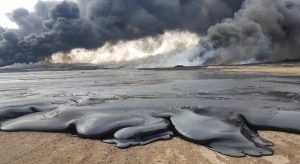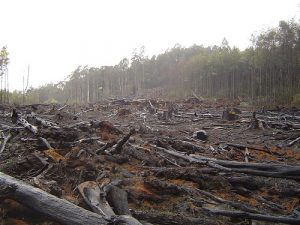Disaster Recovery: What about the environment?
This blog has been written by Klara Vybihalova on disaster recovery. It was one of two blogs which were amongst the highest calibre for the whole cohort in the Culture and Disasters Module ( MSc International and Disaster Management program).
Imagine that you live in a country in conflict. You and your family were forced to abandon your home and flee for fear of violence or persecution and spent countless months or even years fighting to survive. You finally receive the news you have been waiting for: the war is over! You can start rebuilding your life. However, upon returning to your village, you discover that the air is not breathable, because of burning oil pipelines and the water is contaminated causing your children to get sick. How are you supposed to recover when the environment around you is destroyed?
Disaster recovery most often focuses on rebuilding the houses and infrastructure and on restoration of services and livelihoods in communities affected by conflict and natural disasters. But what about the environment? There is a growing consensus that environmental protection is an essential component of the recovery process, especially in terms of public health. Experts in the past have argued that recovery often neglects the environment, making it the “silent casualty” of armed conflict. The question remains as to how far we have come. Let us now focus on the role of the environment in post-conflict recovery.

Children playing near an oil spill left behind by ISIS militants in Quayyarah, Iraq (Carl Court/Getty Images)
Environmental protection forms an integral part of the Sustainable Development Goals and it is therefore currently included in all policies and programmes for post-conflict recovery of the United Nations and all its partner organisations. Nevertheless, there is ample evidence that implementation of these principles is largely inadequate and environment is not considered a priority in all stages of post-conflict recovery. This is alarming especially due to the increasing number of non-international armed conflicts, 40% of which are related to the exploitation of natural resources. Even more troubling is the fact that the majority of internal conflicts is happening in countries vulnerable to natural disasters, further complicating their recovery and environmental protection.
Damages to the environment caused by prolonged armed conflict can range from loss of natural resources and damaged ecosystems to deforestation, air pollution or contaminated water. This is the case for example in Iraq where the burning of oil wells under ISIL’s tactics of scorched earth caused pollution by releasing compounds harmful to human health, oil spills, acid rain and water contamination that poisoned more than 100, 000 people.
Afghanistan has suffered a similar faith with water contamination that in 2016 reached 80% and air pollution killing more than 50 000. The Afghani government has received international assistance on these issues but lack of resources, corruption and overall insecurity have made implementation nearly impossible. Pollution in the country is currently killing more people than those directly harmed by conflict and environmental protection as part of the recovery process remains mostly a rhetoric exercise.
Another example of the negative impact of conflict on the environment is the civil war in Colombia. Its peace agreement left areas previously controlled by the FARC ungoverned and led to massive deforestation. In 2016, the Colombian president announced a 15 year post-conflict plan for Sustainable Colombia supported by the Inter-American Development Bank. In spite of this, deforestation continued, reaching an all-time high in the following year and maintains extremely high rates to this date.
The above mentioned cases seem to paint a grim picture for the environment in countries undergoing post-conflict recovery but all is not lost. The international community has realised the urgent need for new laws and mechanisms that would make environmental protection during and after conflict more efficient, in additional to improving its enforcement. For instance, in 2014 the UN authorised sanctions against wildlife poaching in the Democratic Republic of Congo. The Security Council resolution connected poaching to arms trafficking and declared it a threat to the peace subject to coercive measures under Chapter VII of the UN Charter.
Another sign of progress is the efforts to expand the international humanitarian law applicable in conflicts between states to ensure equal environmental protection in non-international armed conflict. The UN’s International Law Commission is currently analysing the applicability of its draft environmental protection principles to internal conflicts and some experts also propose a strengthening of the existing rules of international environmental law and human rights law for their continued application during conflict.
The increased effort to address the environment-conflict nexus is also marked by the evolving notion of environmental security. In the past, it was understood as the protection of people from nature and its deterioration. More recent definitions of the concept have shifted towards protecting the environment from damages caused by conflict and prevention of conflicts linked to the environment.
Often overlooked is the fact that environmental protection can serve as a tool for conflict prevention and management and play an important role in the peace-building process. Such was the case of Israel and Jordan, two countries officially at war that nevertheless held informal talks to coordinate their actions on the Jordan River. This type of cooperation in connection with natural resources generates a framework for the relationship between two warring parties and helps identify their shared interests. While in this case it enabled the parties to build mutual trust and confidence to bolster their peace negotiations, in other regions, it was a foundations for the creation of shared identities and cooperation on larger issues.
Natural disasters are becoming ever more common as the threat of climate change looms over us. At the same time, developing countries that are most often suffering from the impact of internal or inter-state conflict are extremely vulnerable to the effects of natural disasters and destruction of their environment. Armed conflict should no longer serve as an excuse to forget about the environment and instead become an opportunity for all-round development as part of the recovery. It is time for the all of us to wake up and make the environment a humanitarian priority.
References:
Barbu, Constantin-Horia, Camelia Sand and Letitia Oprean. “Introduction to Environmental Security,” in Strategies to Enhance Environmental Security in Transition Countries, edited by Ruth N. Hull, Constantin-Horia Barbu and Nadezhda Goncharova, 7-8. Dordrecht: Springer, 2007.
Burke, Tom. “Public Health and Environmental Protection.” The EPA blog, April 11, 2016. https://blog.epa.gov/2016/04/11/public-health-and-environmental-protection/.
Court, Carl. Joint Forces Battle To Retake Iraqi City Of Mosul From ISIS. October 21, 2016. Qayyarah, Iraq. https://www.gettyimages.co.uk/detail/news-photo/boy-pauses-on-his-bike-as-he-passes-an-oil-field-that-was-news-photo/616059826.
Crustmania. Deforestation. September 4, 2006. Colombia. http://www.flickr.com/photos/crustmania/10094847976/in/photostream/.
Kovach, Tim and Ken Conca. “After Conflict, Peacebuilding and Recovery Efforts Too Often Miss the Environment.” New Security Beat, August 29, 2016. https://www.newsecuritybeat.org/2016/08/peacebuilding-recovery-efforts-environment/.
PAX. Living under a black sky: Conflict pollution and environmental health concerns in Iraq. Utrecht: Colophon, 2017).
Health Effects Institute. “State of Global Air.” Accessed March 20, 2019, https://www.stateofglobalair.org/data/#/health/plot.
Monitoring of the Andean Amazon Project. “MAAP #97: Deforestation Surge in the Colombian Amazon, 2018 Update.” Accessed March 22, 2019, https://maaproject.org/2019/colombia-2018-4/.
Peters, Anne. “Novel practice of the Security Council: Wildlife poaching and trafficking as a threat to the peace.” European Journal of International Law, February 12, 2014. https://www.ejiltalk.org/novel-practice-of-the-security-council-wildlife-poaching-and-trafficking-as-a-threat-to-the-peace/.
Pretorius, Jeanique. “Environmental protection in non-international armed conflicts: finding the way forward.” Conflict and Environment Observatory, March 15, 2019. https://ceobs.org/environmental-protection-in-non-international-armed-conflicts-finding-the-way-forward/.
Swain, Ashok. “Water and post-conflict peacebuilding,” Hydrological Sciences Journal 61, no. 7 (2016): 1313-1322, https://doi.org/10.1080/02626667.2015.1081390.
Trew, Bel. “Thousands of carp die in mysterious circumstances as Iraq’s wáter woes worsen.” Independent, November 6, 2018. https://www.independent.co.uk/news/world/ middle-east/iraq-fish-carp-dead-euphrates-river-water-poisoning-pollution-babel-baghdad-a8620766.html.
United Nations. Charter of the United Nations. Geneva: United Nations, 1945.
United Nations. “Sustainable Development Goals.” Sustainable Development Goals Knowledge Platform. United Nations. Accessed March 21, 2019. https://sustainabledevelopment.un.org/?menu=1300.
United Nations Environment Programme. Addressing the Role of Natural Resources in Conflict and Peacebuilding. Nairobi: United Nations, 2015.
United Nations Environment Programme. “Environment is the silent casualty of armed conflict.” Accessed March 21, 2019. https://www.unenvironment.org/news-and-stories/press-release/environment-silent-casualty-armed-conflict.
United Nations Office of Legal Affairs. “Summaries of the Work of the International Law Commission.” United Nations. Accessed March 22, 2019. http://legal.un.org/ilc/summaries/8_7.shtml.
United Nations Regional Information Centre for Western Europe. “40% of conflicts linked to use of natural resources.” United Nations Regional Information Centre for Western Europe. United Nations. Accessed March 20, 2019. https://www.unric.org/en/latest-un-buzz/28808-international-day-for-preventing-the-exploitation-of-the-environment-in-war-and-armed-conflict-
UNISDR, Sendai Framework for Disaster Risk Reduction 2015 – 2030. Geneva: United Nations, 2015.
Weinthal, Erika. “Case Study: Cooperation around Shared Water in the Jordan River.” SDG Academy MOOC Environmental Security and Sustaining Peace. Accessed March 22, 2019. https://player.vimeo.com/external/240022465.hd.mp4?s=05867f7a59634cb61e573201035f057dcba282ac&profile_id=174&download=1
Weir, Doug. “Calculating the environmental benefits of peace in Colombia.” New Internationalist, March 17, 2016. https://newint.org/blog/2016/03/17/colombia-environmental-benefits-of-peace.
Weir, Doug. “The slow violence of pollution in Afghanistan”, Conflict and Environment Observatory, June 18, 2018. https://ceobs.org/the-slow-violence-of-pollution-in-afghanistan/.
Wolf, Aaron T., Annika Kramer, Alexander Carius and Geoffrey D. Dabelko. “Water can be a pathway to peace, not war,” Navigating Peace, no. 1 (July 2006): 1-6, Accessed March 23, 2019. https://www.wilsoncenter.org/publication/water-can-be-pathway-to-peace-not-war-no-1.
Zwijnenburg, Wim. “Environmental Security in Times of Armed Conflict.” New Security Beat, November 6, 2018. https://www.newsecuritybeat.org/2018/11/environmental-security-times-armed-conflict/.
Zwijnenburg, Wim. “Apocalyptic” air pollution created by ISIL. January 2017. Qayyarah, Iraq. https://qz.com/1182389/isil-is-lighting-oil-wells-on-fire-as-they-retreat-and-no-one-is-paying-attention/.




0 Comments